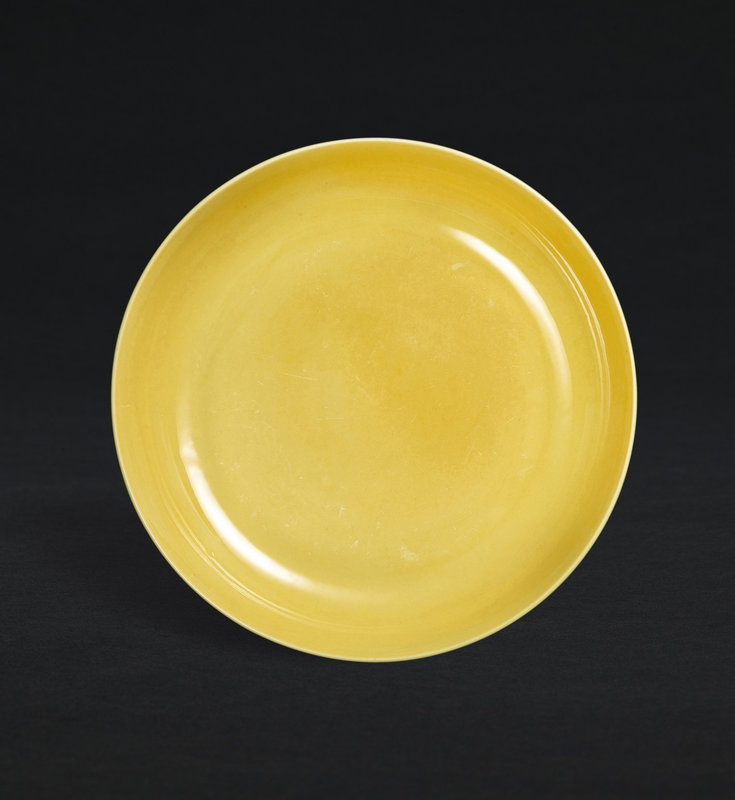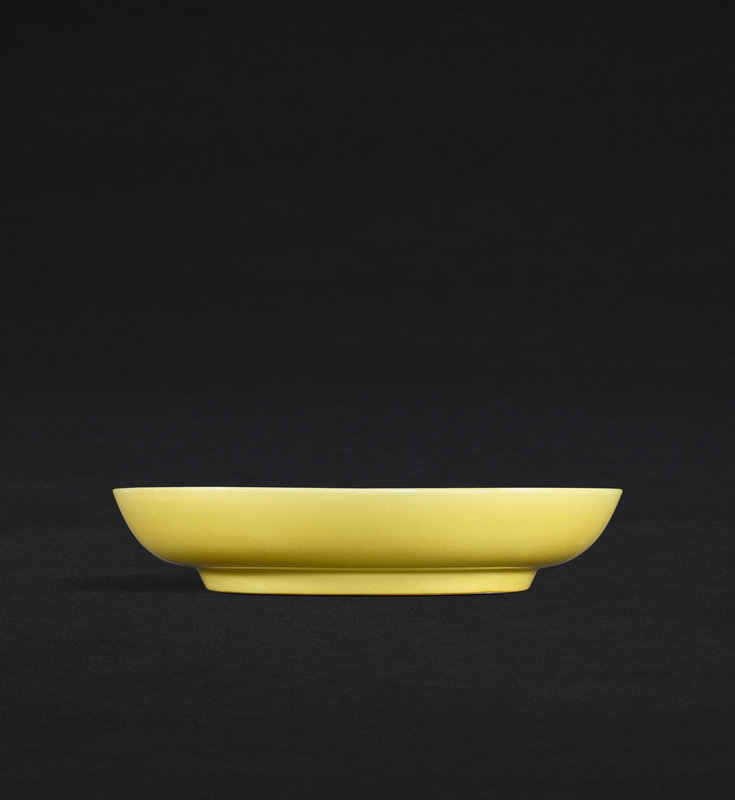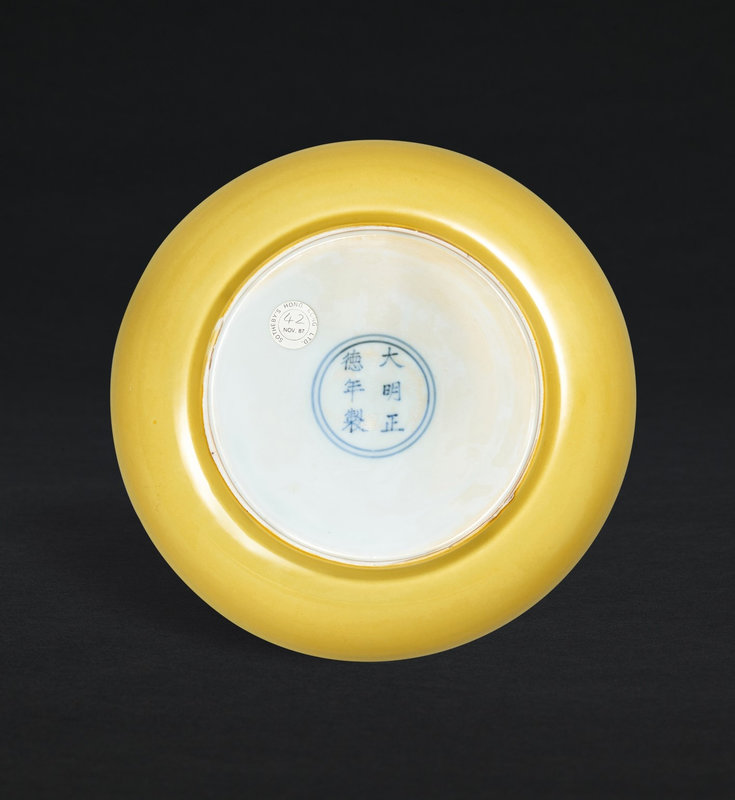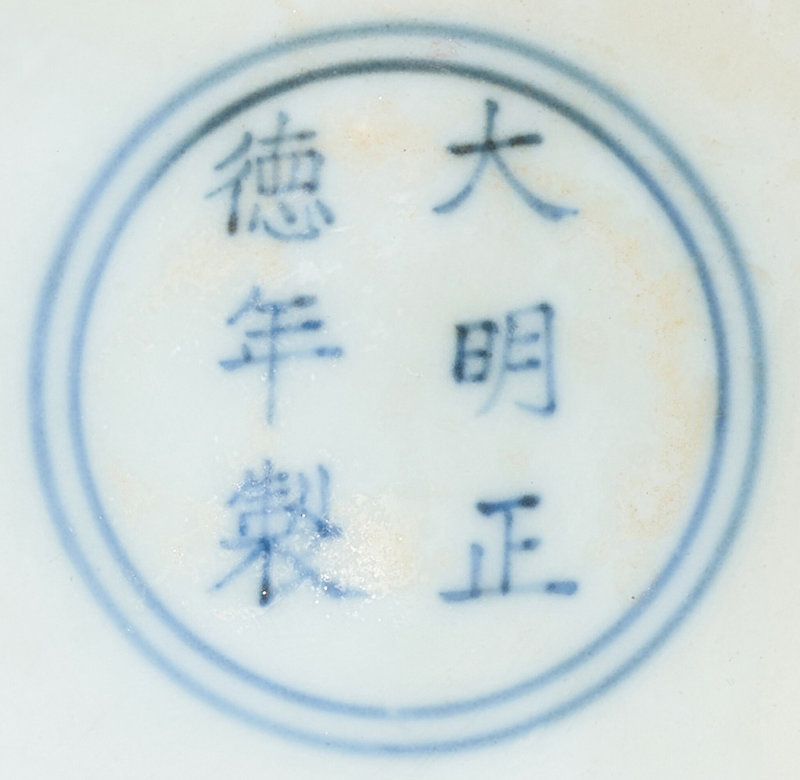Sotheby's. The Leshantang Collection – Treasures of Chinese Art from the Tsai I-Ming Collection, Hong Kong, 8 October 2023
A fine yellow-glazed dish, Mark and period of Zhengde
Lot 138. The Leshantang Collection. A fine yellow-glazed dish, Mark and period of Zhengde (1506-1521); 22.7 cm. Lot Sold 2,159,000 HKD (Estimate 200,000 - 300,000 HKD). © Sotheby's 2023
with shallow rounded sides resting on a tapered foot, applied overall with an even pale yellow glaze, save for the base left white and inscribed with a six-character reign mark in underglaze blue within a double circle.
Provenance: Sotheby's Hong Kong, 24th November 1981, lot 136.
Sotheby's Hong Kong, 25th November 1987, lot 42.
Literature: The Leshantang Collection of Chinese Porcelain, Taipei, 2005, pl. 15.
Note: Deceptively simple in form and colour, the production of monochrome porcelain such as the present imperial yellow dish requires the highest level of skill and utmost precision from the purity of the clay, potting, firing to glazing, which entails the application of low-fired yellow lead glaze onto high-fired white-glazed porcelain. The slightest irregularity or smallest imperfection would result in the rejection and destruction of the entire piece. Aptly termed 'imperial yellow', yellow glaze had always been reserved for imperial court use since the introduction of yellow monochrome porcelain at the beginning of the Ming dynasty, though on rare occasions, yellow porcelain wares were also presented as diplomatic gifts to political and religious leaders beyond China.
The present dish is notable for its smooth, even and soft yellow glaze, characteristic of imperial yellow wares of the Zhengde reign (1506–21) and ultimately became one of the most coveted yellow colours of the Ming dynasty after Hongzhi. This aesthetically pleasing shade of yellow was ingeniously achieved through a slight increase in the amount of iron oxide in glaze solution. This shade was so admired that even Kangxi Emperor (r. 1662-1722) from the succeeding dynasty attempted to replicate it; see a Kangxi imperial yellow dish with an apocryphal Zhengde mark in the Beijing Palace Museum, illustrated in Imperial Porcelains from the Reign of Hongzhi and Zhengde in the Ming Dynasty, vol. 2, Beijing, 2017, pl. 338.
Boasting a larger size among its peers, this dish measures 22.7 cm in diameter. For Zhengde imperial yellow dishes of comparable presence held in museums, see two examples in the Beijing Palace Museum, illustrated in ibid., pls 323 and 325; another in the Asia Society Collection (accession number 1979.180) donated by Mr and Mrs John D. Rockefeller 3rd; a third example in the Eli Lilly Collection in the Indianapolis Museum of Art (accession no. 60.105). Compare also two auction examples, the first sold in these rooms, 8th April 2013, lot 3059; the second included in the exhibition Ming Porcelain, Marchant, London, 2009, cat. no. 12, and sold in our London room, 15th May 2013, lot 105.

/https%3A%2F%2Fprofilepics.canalblog.com%2Fprofilepics%2F1%2F0%2F100183.jpg)
/https%3A%2F%2Fstorage.canalblog.com%2F03%2F02%2F119589%2F96711876_o.jpg)
/https%3A%2F%2Fstorage.canalblog.com%2F11%2F31%2F119589%2F94773502_o.jpg)
/https%3A%2F%2Fstorage.canalblog.com%2F20%2F83%2F119589%2F94772815_o.jpg)
/https%3A%2F%2Fstorage.canalblog.com%2F26%2F72%2F119589%2F75604929_o.jpg)
/https%3A%2F%2Fstorage.canalblog.com%2F59%2F60%2F119589%2F26458628_o.jpg)






/http%3A%2F%2Fstorage.canalblog.com%2F99%2F91%2F119589%2F129076442_o.jpg)
/http%3A%2F%2Fstorage.canalblog.com%2F56%2F32%2F119589%2F128673310_o.jpg)
/http%3A%2F%2Fstorage.canalblog.com%2F37%2F92%2F119589%2F128012993_o.jpg)
/http%3A%2F%2Fstorage.canalblog.com%2F83%2F40%2F119589%2F127937979_o.jpg)